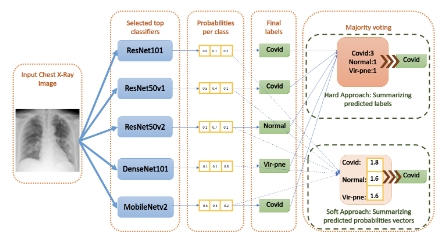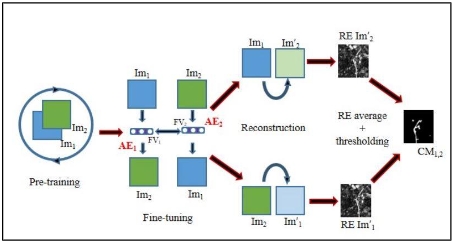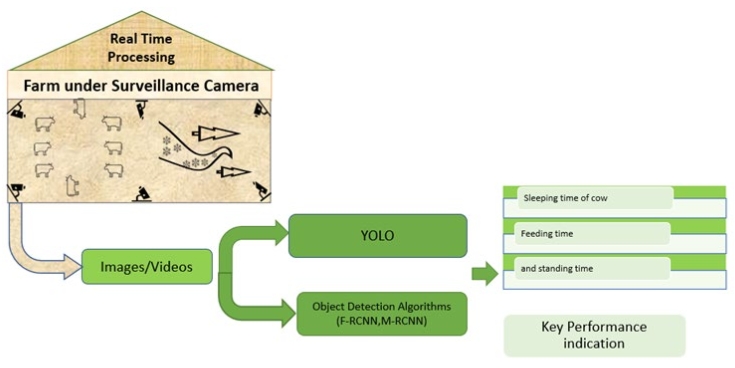Application of machine vision in drying process modeling of carrot slices
Abstract
In this current research, the drying characteristics of carrot slices dried in a convective hot-air dryer are analyzed employing image analysis to determine the most significant factor. From the acquired images, nine parameters viz. redness (R), greenness (G), blueness (B), lightness (L), redness (a), yellowness (b), energy, entropy, and upper surface area of carrot slices were calculated using the algorithm developed in MATLAB 2015a. Boruta feature selection algorithm in the R console showed lightness, redness, and energy were the most significant features among calculated parameters. Additionally, single-layer feed-forward artificial neural network (ANN) architecture with three inputs (hot air temperature, thickness of slices, drying time), and outputs namely lightness, redness, and energy with one hidden layer was used to model input variables to that of responses. Multiple regression models are employed to optimize the drying condition by further assessing the behavior of response variables with hot air temperature and thickness of slices as inputs and lightness, redness, and energy as outputs. The lightness and redness of samples are found to be decreasing with an increase in temperature and a decrease in thickness. Whereas, the effect of these input parameters on energy, the measure of homogeneity of the product surface, is found to be reversed to that of the effect on lightness and redness. Lightness and redness are set to be highest, whereas energy was kept to be lowest. Convective hot air temperature of 60 ℃ and 7 mm thickness sample was found to provide the best quality product within the experiment range.
References
[1]Food and Agriculture Organization of the United Nations Carrots and Turnips, 2020. Available online: http: //www.fao.org/faostat/en/#data/QC/visualize. (Accessed on 10 October 2022).
[2]Ahmad T, Cawood M, Iqbal Q, et al. Phytochemicals in Daucus carota and Their Health Benefits. Foods. 2019; 8(9): 424. doi: 10.3390/foods8090424
[3]Dhalsamant K, Tripathy PP, Shrivastava SL. Effect of pretreatment on rehydration, colour and nanoindentation properties of potato cylinders dried using a mixed‐mode solar dryer. Journal of the Science of Food and Agriculture. 2017; 97(10): 3312–3322. doi: 10.1002/jsfa.8181
[4]Wang H, Fang XM, Sutar PP, et al. Effects of vacuum-steam pulsed blanching on drying kinetics, colour, phytochemical contents, antioxidant capacity of carrot and the mechanism of carrot quality changes revealed by texture, microstructure and ultrastructure. Food Chemistry. 2021; 338: 127799. doi: 10.1016/j.foodchem.2020.127799
[5]Sharma S, Dhalsamant K, Tripathy PP. Application of computer vision technique for physical quality monitoring of turmeric slices during direct solar drying. Journal of Food Measurement and Characterization. 2018; 13(1): 545-558. doi: 10.1007/s11694-018-9968-0
[6]Sharma S, Dhalsamant K, Tripathy PP, et al. Quality analysis and drying characteristics of turmeric (Curcuma longa L.) dried by hot air and direct solar dryers. LWT. 2021; 138: 110687. doi: 10.1016/j.lwt.2020.110687
[7]Mudahar GS, Toledo RT, Floros JD, et al. Optimization of Carrot Dehydration Process using Response Surface Methodology. Journal of Food Science. 1989; 54(3): 714-719. doi: 10.1111/j.1365-2621.1989.tb04688.x
[8]Dey D, Dhalsamant K, Tripathy PP. Effect of different pre-treatments on rehydration kinetics of solar and hot-air dried Fuji apple slices. Trends in Horticulture. 2023; 6(2): 3185. doi: 10.24294/th.v6i2.3185
[9]Kakani V, Nguyen VH, Kumar BP, et al. A critical review on computer vision and artificial intelligence in food industry. Journal of Agriculture and Food Research. 2020; 2: 100033. doi: 10.1016/j.jafr.2020.100033
[10]Jahanbakhshi A, Kheiralipour K. Evaluation of image processing technique and discriminant analysis methods in postharvest processing of carrot fruit. Food Science & Nutrition. 2020; 8(7): 3346-3352. doi: 10.1002/fsn3.1614
[11]Tian H, Wang T, Liu Y, et al. Computer vision technology in agricultural automation —A review. Information Processing in Agriculture. 2020; 7(1): 1-19. doi: 10.1016/j.inpa.2019.09.006
[12]Zhu H, Yang L, Sun Y, et al. Identifying carrot appearance quality by an improved dense CapNet. Journal of Food Process Engineering. 2020; 44(1). doi: 10.1111/jfpe.13586
[13]Mohebbi M, Akbarzadeh-T MR, Shahidi F, et al. Computer vision systems (CVS) for moisture content estimation in dehydrated shrimp. Computers and Electronics in Agriculture. 2009; 69(2): 128-134. doi: 10.1016/j.compag.2009.07.005
[14]Aghbashlo M, Hosseinpour S, Mujumdar AS. Application of Artificial Neural Networks (ANNs) in Drying Technology: A Comprehensive Review. Drying Technology. 2015; 33(12): 1397-1462. doi: 10.1080/07373937.2015.1036288
[15]El-Mesery H, Mao H, Abomohra A. Applications of Non-destructive Technologies for Agricultural and Food Products Quality Inspection. Sensors. 2019; 19(4): 846. doi: 10.3390/s19040846
[16]Ebrahimi E, Mollazade K, Babaei S. Toward an automatic wheat purity measuring device: A machine vision-based neural networks-assisted imperialist competitive algorithm approach. Measurement. 2014; 55: 196-205. doi: 10.1016/j.measurement.2014.05.003
[17]Sampson DJ, Chang YK, Rupasinghe HPV, et al. A dual-view computer-vision system for volume and image texture analysis in multiple apple slices drying. Journal of Food Engineering. 2014; 127: 49-57. doi: 10.1016/j.jfoodeng.2013.11.016
[18]Majumdar S, Jayas DS. Classification of cereal grains using machine vision: IV. Combined morphology, color, and texture models. Transactions of the ASAE. 2000; 43(6): 1689-1694. doi: 10.13031/2013.3069
[19]Zhang Y, Wang S, Ji G, et al. Fruit classification using computer vision and feedforward neural network. Journal of Food Engineering. 2014; 143: 167-177. doi: 10.1016/j.jfoodeng.2014.07.001
[20]Fathi M, Mohebbi M, Razavi SMA. Application of Image Analysis and Artificial Neural Network to Predict Mass Transfer Kinetics and Color Changes of Osmotically Dehydrated Kiwifruit. Food and Bioprocess Technology. 2009; 4(8): 1357-1366. doi: 10.1007/s11947-009-0222-y
[21]Hosseinpour S, Rafiee S, Mohtasebi SS. Application of Image Processing to Analyze Shrinkage and Shape Changes of Shrimp Batch during Drying. Drying Technology. 2011; 29(12): 1416-1438. doi: 10.1080/07373937.2011.587620
[22]Hosseinpour S, Rafiee S, Mohtasebi SS, et al. Application of computer vision technique for on-line monitoring of shrimp color changes during drying. Journal of Food Engineering. 2013; 115(1): 99-114. doi: 10.1016/j.jfoodeng.2012.10.003
[23]Zenoozian MS, Feng H, Razavi SMA, et al. Image analysis and dynamic modeling of thin-layer drying of osmotically dehydrated pumpkin. Journal of Food Processing and Preservation. 2008; 32(1): 88-102. doi: 10.1111/j.1745-4549.2007.00167.x
[24]Sturm B, Hofacker WC, Hensel O. Optimizing the Drying Parameters for Hot-Air–Dried Apples. Drying Technology. 2012; 30(14): 1570-1582. doi: 10.1080/07373937.2012.698439
[25]Jahns G, Nielsen HM, Paul W. Measuring image analysis attributes and modelling fuzzy consumer aspects for tomato quality grading. Comput. Electron. Agric. 2001; 31(1): 17-29. doi: 10.1016/S0168-1699(00)00171-X
[26]Blaschke T. Object based image analysis for remote sensing. ISPRS Journal of Photogrammetry and Remote Sensing. 2010; 65(1): 2-16. doi: 10.1016/j.isprsjprs.2009.06.004
[27]Behroozi Khazaei N, Tavakoli T, Ghassemian H, et al. Applied machine vision and artificial neural network for modeling and controlling of the grape drying process. Computers and Electronics in Agriculture. 2013; 98: 205-213. doi: 10.1016/j.compag.2013.08.010
[28]Dhalsamant, K., Tripathy, P. P., & Shrivastava, S. L. (2017). Moisture transfer modeling during solar drying of potato cylinders considering shrinkage. International Journal of Green Energy, 14(2), 184-195. doi: 10.1080/15435075.2016.1256290
[29]Hosseinpour S, Rafiee S, Aghbashlo M, et al. Computer Vision System (CVS) for In-Line Monitoring of Visual Texture Kinetics During Shrimp (Penaeus Spp.) Drying. Drying Technology. 2014; 33(2): 238-254. doi: 10.1080/07373937.2014.947513
[30]Fernandez L, Castillero C, Aguilera JM. An application of image analysis to dehydration of apple discs. Journal of Food Engineering. 2005; 67(1-2): 185-193. doi: 10.1016/j.jfoodeng.2004.05.070
[31]Poona NK, Ismail R. Using Boruta-Selected Spectroscopic Wavebands for the Asymptomatic Detection of Fusarium Circinatum Stress. IEEE Journal of Selected Topics in Applied Earth Observations and Remote Sensing. 2014; 7(9): 3764-3772. doi: 10.1109/jstars.2014.2329763
[32]Lim DK, Long NP, Mo C, et al. Combination of mass spectrometry-based targeted lipidomics and supervised machine learning algorithms in detecting adulterated admixtures of white rice. Food Research International. 2017; 100: 814-821. doi: 10.1016/j.foodres.2017.08.006
[33]Min W, Zhou P, Xu L, et al. From Plate to Production: Artificial Intelligence in Modern Consumer-Driven Food Systems. arXiv preprint arXiv:2311.02400
[34]Banda T, Farid AA, Li C, et al. Application of machine vision for tool condition monitoring and tool performance optimization–a review. The International Journal of Advanced Manufacturing Technology. 2022; 121(11-12): 7057-7086. doi: 10.1007/s00170-022-09696-x
[35]Zheng C, Sun DW, Zheng L. Recent applications of image texture for evaluation of food qualities—A review. Trends in Food Science & Technology. 2006; 17(3): 113-128. doi: 10.1016/j.tifs.2005.11.006
[36]Gao X, Tan J. Analysis of expanded‐food texture by image processing part II: Mechanical properties. Journal of Food Process Engineering. 1996; 19(4): 445-456. doi: 10.1111/j.1745-4530.1996.tb00404.x
[37]Brosnan T, Sun DW. Improving quality inspection of food products by computer vision—A review. J. Food Eng. 2004; 61: 3-16. doi: 10.1016/S0260-8774(03)00183-3
[38]Haralick RM, Shanmugam K, Dinstein I. Textural Features for Image Classification. IEEE Transactions on Systems, Man, and Cybernetics. 1973; SMC-3(6): 610-621. doi: 10.1109/tsmc.1973.4309314
[39]Kursa MB, Rudnicki WR. Feature Selection with theBorutaPackage. Journal of Statistical Software. 2010; 36(11). doi: 10.18637/jss.v036.i11
[40]Chen J, Chia N, Kalari KR, et al. Multiple sclerosis patients have a distinct gut microbiota compared to healthy controls. Scientific Reports. 2016; 6(1). doi: 10.1038/srep28484
[41]Chen CR, Ramaswamy HS, Alli I. Prediction of quality changes during osmo-convective drying of blueberries using neural network models for process optimization. Drying Technology. 2001; 19(3-4): 507-523. doi: 10.1081/drt-100103931
[42]Cheng F, Chen FN, Ying YB. Image Recognition of Unsound Wheat Using Artificial Neural Network. 2010 Second WRI Global Congress on Intelligent Systems. Published online December 2010. doi: 10.1109/gcis.2010.220
[43]Uhlig S, Colson B, Hettwer K, et al. Valid machine learning algorithms for multiparameter methods. Accreditation and Quality Assurance. 2019; 24(4): 271-279. doi: 10.1007/s00769-019-01384-w
[44]Dhalsamant K. Development, validation, and comparison of FE modeling and ANN model for mixed‐mode solar drying of potato cylinders. Journal of Food Science. 2021; 86(8): 3384-3402. doi: 10.1111/1750-3841.15847
[45]Dhalsamant K, Tripathy PP, Shrivastava SL. Effect of sodium metabisulfite pretreatment on micrographs, surface roughness and X-ray diffraction analyses of solar dried potato cylinders. Innovative Food Science & Emerging Technologies. 2018; 47: 399-411. doi: 10.1016/j.ifset.2018.03.014
[46]Dhalsamant K, Tripathy PP, Shrivastava SL. Heat transfer analysis during mixed-mode solar drying of potato cylinders incorporating shrinkage: Numerical simulation and experimental validation. Food and Bioproducts Processing. 2018; 109: 107-121. doi: 10.1016/j.fbp.2018.03.005
[47]Doymaz I. Drying kinetics, rehydration and colour characteristics of convective hot-air drying of carrot slices. Heat and Mass Transfer. 2016; 53(1): 25-35. doi: 10.1007/s00231-016-1791-8
[48]Demiray E, Tulek Y. Color Degradation Kinetics of Carrot (Daucus carota L.) Slices during Hot Air Drying. Journal of Food Processing and Preservation. 2014; 39(6): 800-805. doi: 10.1111/jfpp.12290
Copyright (c) 2023 Gourab Basu, Kshanaprava Dhalsamant, Punyadarshini Punam Tripathy, Sonu Sharma

This work is licensed under a Creative Commons Attribution 4.0 International License.










